Jewels of the Silk Road: A Grand Tour of Uzbekistan
Read about our recent trip to Central Asia with more image galleries
Previously, on “Back in the USSR”:
In 1984 I responded to an invitation from the Soviet Sports Committee to visit the Pamir, Central Asia & the Caucasus. We explored the steppes below Pik Lenin and helicoptered into Fortembek base camp for Pik Communizm. Now we were leaving to visit the Silk Road cities of Central Asia
27 JUL Fri Border check,
Leaving Achitach base camp in the dark at 5:30 am. Left camp in the dark at 5:30. Bumpy ride across predawn hills & washes. Beautiful sunrise over Altai & Pamir plateau. Then golden touches to Lenin & other peaks of the Trans Altai. We were about 20 km from China when we encountered a Soviet checkpoint in the middle of nowhere; as isolated as Robert Johnson’s crossroads .
3.pm — sitting outside Osh airport. Had another great picnic — kielbasi, cheese, breads, juice & chocolate. Sat by stream watching tankers & other trucks go by — no mufflers, vomiting clouds of black diesel smoke (we were, luckily, not affected)
Fly to Tashkent –
Our second lunch (the airport meal was just to tide us over!), fruit, meat-dumpling soup, giant meatballs, THEN excellent shashlik. (Can’t remember, but I doubt they let us free without dessert)
7:30pm Arrived at Hotel Tashkent — once more we’re whisked thru airport for our departure — no waiting rooms, boarding passes! On arrival no need for baggage claim – it would follow later. But terribly hot. These hotels recall European hotels of the 30-40s as seen in movies. But while some ostentations, many details not completed, as if half-fast were good enough. (base boards don’t match up, painting haphazard, framing off center, …) High ceilinged lobbies, but with uncertain elevators. Broad halls on each floor with a concierge/watcher. Inside the spacious rooms, the electric services & plumbing are clumsy – exposed wires, taps not always consistent – and toilets usually connected to same inputs as showers as we learned by experience)
Click on last icon on map to view
28 JUL Sat – Tashkent morning tour, nothing special — pretty, ‘modern’ buildings in Soviet heroic style. Lots of fountains and parks. Ended morning for a break at a teahouse. Many in group becoming restive, but this is an Asian city, and plans a mere suggestion, but things eventually happen. As Sverta commented, “Inshallah” (“If Allah wills), worth cultivating by any traveler.
At lunch Sverta continued talk of American/English writers, easily available in English. She’s reading Fowle’s Daniel Martin now, finds it difficult though she likes his others (Eg The French Lieutenant’s Woman, The Magus. )
Also read Heller, Salinger, O’Neil, Tennessee William, and Joyce’s Portrait of the Artist as a Young Man .(which I re-read every few years) Ulysses is available, but she hasn’t read it yet.. She asked us about Americans’s views on Solzhenitsyn. Has read One Day In The Life Of Ivan Denisovich & part of Gulag Archipelago . Started to talk more of the Revolution and Stalin, but then lunch ended to be resumed later at our after dinner talks enhanced by copius vodka. Many of the other Russians we’ve talked with know American literature – likely better than most Americans. Even ‘Gorky Park’
| < |
Taxiing now on the prop plane to Bokhara.
Ridiculously hot. Sweat pouring out faster than liquid coming in. But we’re never satisfied – just a few days ago we were kvetching about how cold it was. But it will be nice to return to cool Caucasian mountains next week, more like home in the North Cascades.
Interesting views. We’re flying over Central Asian desert. Flat irrigated fields run right to the edge of large lake/seas with scattered villages & towns. Few cars on the roads. Suddenly the land buckles, erupting with sharp spined ridges. Looking down the spine you imagine you can see tectonic plates exposed – shift happens!. Just as abruptly the hills are ironed out revealing a wide irrigated swathes of cultivation. Roads lightly checker the plains linking many more buildings. The previous browner areas had only a few buildings and yurts, mostly concentrated at isolated crossroads.
Arrived in Bokhara about 5pm (Now more commonly known as Bukhara). First exploratory walk of mosques and medressehs. Beautiful inlay work. Clean yellow brick buildings. The exteriors are starkly beautiful with patterns formed from bricks alone.
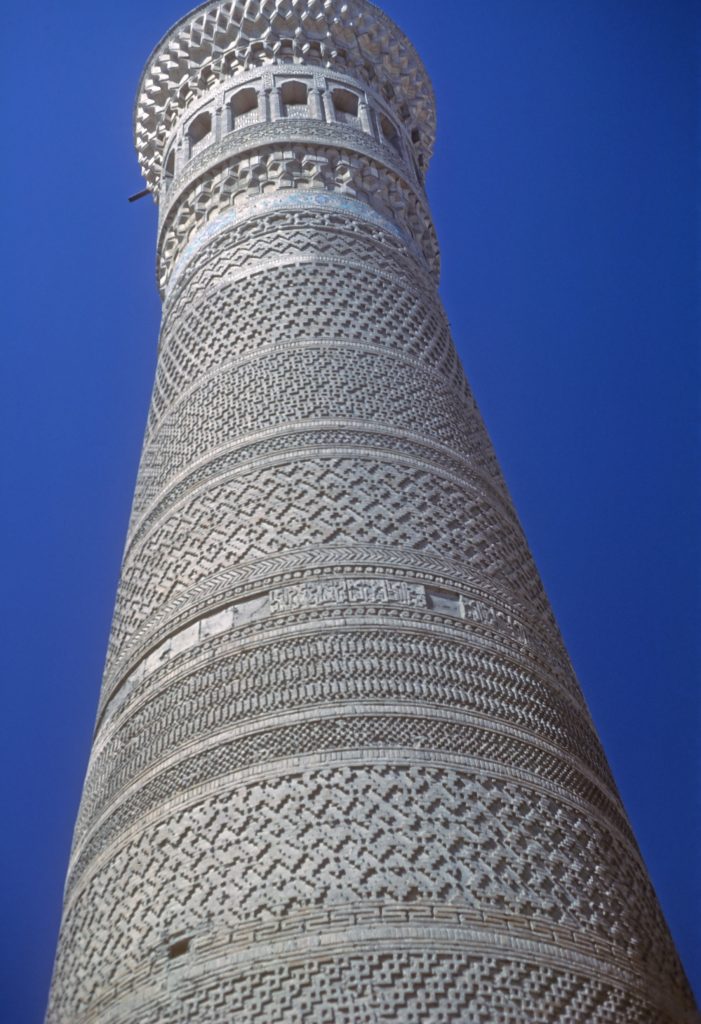
Supper at 8:30 — Salad and Uzbek soup (4″ sq noodles, chunks of meat & vegie, lightly spiced).
After dinner we wandered back to central Bokhara
to find a bar. None open. We happened on an Uzbek party in a cafe and were invited in — people dancing to what sounded like an Uzbeki cover of Del Shannon’s ‘Runaway’. Very pleasant place to walk around in at night — much like Kathmandu (in the 80s) or Venice. Narrow twisting streets, mud daubed walls. Central area is a series of parks and public buildings. All paved and all very clean.
Some light relief from G, no matter how much we re-assure him, still worries we’d be mugged if we went down the streets. Also, that the lights would go out.
29 JUL SUN We were now in the land of intrigue
and treachery from the 16th century Moguls to the the 19th century exploration and espionage that became known as the ‘Great Game’ between Britain and Russia. On each of our stops, local guides eagerly entertained us with stories of this history, relishing tales of the ‘specially bred vermin’ of the pit. [I’ve since read widely on these adventures, but that requires a post of its own] The emir Nasrullah was known as a particularly unreliable host. Our first stop was the ‘Ark’, a palace /dungeon with a gruesome reputation. Around 1840 Nasrullah capriciously turned on British visitors he had previously treated as welcome guests and had them thrown into the infamous ‘pit’ dungeon. ‘This horrid dungeon,‘ wrote a later visitor, ‘in which he was confined with two thieves and a murderer, swarmed with innumerable ticks and every disgusting species of vermin, which are especially reared to annoy the wretched prisoners; and should this prison by any extraordinary chance be without inmates, that the vermin might not perish they are supplied with rations of raw meat.’
It was with relief from these lurid tales to cross the square to visit the Bolo Haouz Mosque, built in 1712. The 20 painted wood columns, added in 1920, were topped by traditional stalactite capitals, merging thru spandrels to the support the ceiling.
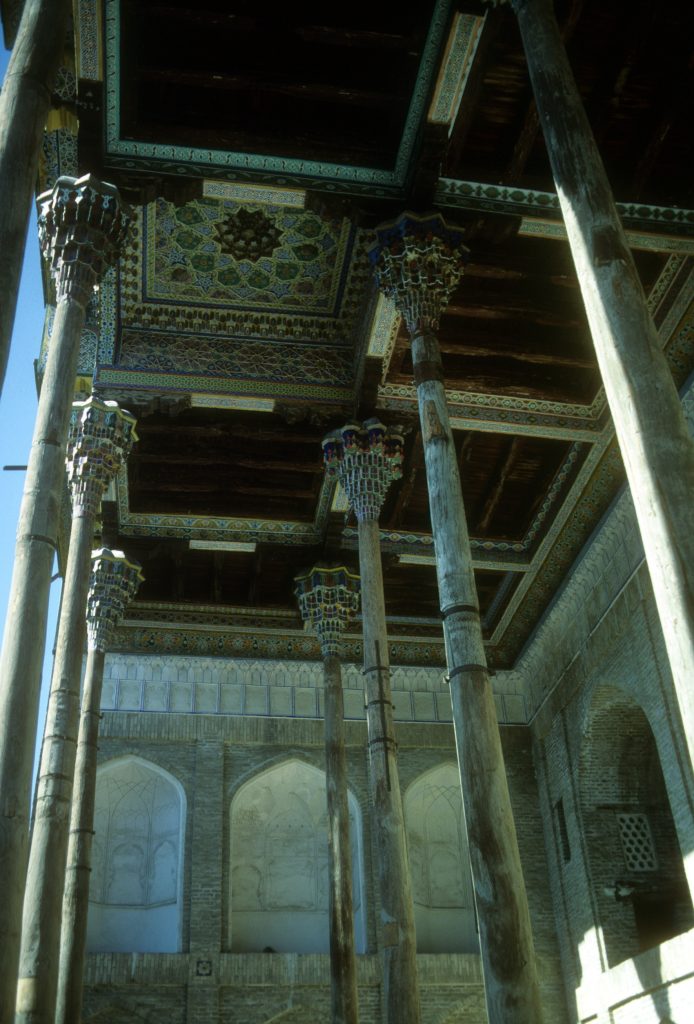
Further on, we visited the Ismail Samani Mausoleum considered to be the most ancient building of Central Asia (circa 10th century) The brickwork is laid out in a pattern that resembles a wickerwork basket, with four solidly built brickwork columns at the corners. It used squinches to solve the architectural problem of placing transition a round dome on a square base. It also introduced the precursor of muqarnas, or stalactite-vaulting, that became hallmark of Islamic decorative architecture the next step in the evolution of the the squinch Squinches migrated the western world around the 12th century.
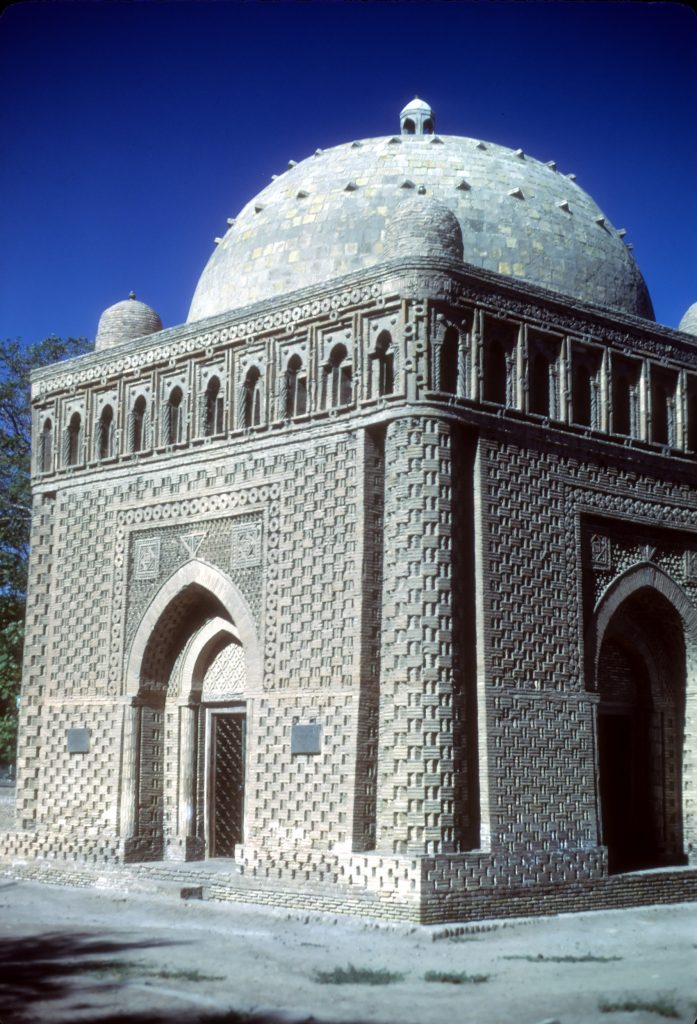
[My fascination with ancient temples, cathedrals, mosaics and mosques has led to a portfolio of architectural elements from around the world. I’ve started a new section on my blog as Elements of Architecture ]
For something completely different , we moved on to the bazaar. As I wandered among the spice sellers, I was attracted to silvered covered betel nuts (similar to paan in India). An old man let me sample one, then fumbled under counter & surreptitiously unwrapped a small parcel to display a resinous black lump. I declined to make an offer since I feared I might become the owner of this piece of opium.
After lunch (egg drop soup, nicely rare shashlik) we finished our tour at the local market — large wonderful amalgam of sellers – clothes, breads and all kinds of food. Also looked at Bukhara rugs at 500R, but not as fine as the one I had at home. (in 1984 the exchange rate was 0.7 Soviet rubles for 1 USD.)

–
We then sampled ‘apricot’ nuts –
a pistachio like nut, covered with white powder. [Many years later I found these sold by street vendors in Turkey in the spring – they have an edible fuzzy green shell and a firm white kernel. Tart but delicious]
Kvass is sold by the glass from 100 gallon wheeled tanks (20 kopeks). It’s made from a mash of rye bread or rye flour and malt – a 12 hr fermentation and popular drink (aand healthy) drink is ready. A true market, visited by women and many men wearing traditional garb.
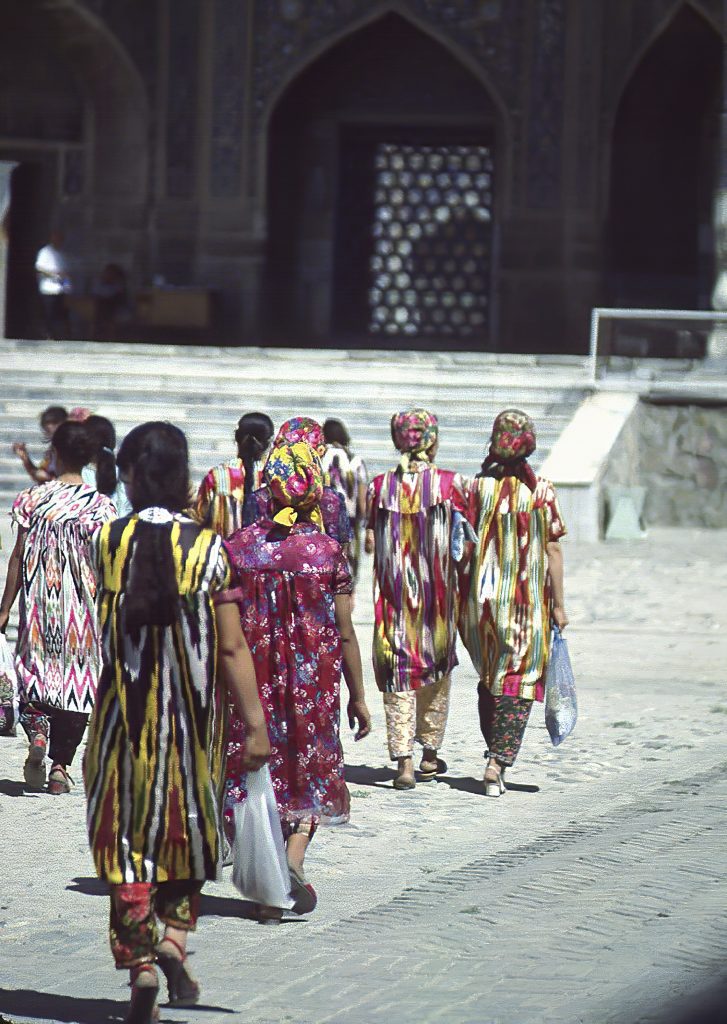
After a long ride we arrived at Avicenna (Ibn Sina – I hope you remember that as the renamed Pik Communizm in the Pamir) museum, looking forward to discovering more about this medieval genius. Instead, we were bored by a long pedagogical talk and nothing of interest in the displays. “Avicenna’s 4th book which deals with cancer has been lost. If found it would provide us with the cure.”
The summer palace was more interesting. Then a swim stop. By this time (5 pm) we were hot, tired and still THIRSTY, with nary a kvas wagon to be seen. Some went swimming, while others found some slightly cooler shade. Then back to the hotel for mineral water & beer.
Supper was uneventful but delicious — a hearty pilaf (raisins, peppers, and lamb) with a vodka toast (or 3). After some went to the cultural dance show, Mike, Peter, Sverta & 2 local guides & I stayed on & finished another liter (or 2?) of vodka. Amid frequent toasts, talk rambled — personal goals, Solaris, climbing, etc. Having a ‘personal’ travel agent was a difficult concept for the Russians to digest. We moved outside, strolling walk in the cool evening, continuing conversations about advertising, narcotics policies of our respective nations & puns.
30 July Monday
In the morning, where we visited a gold embroidery factory and collective farm (many hothouses) where we were serenaded by a kindergarten for series of songs). Then a short (35′) hot plane ride to Samarkand and lunch (2 pm). zakoski, soup & excellent pilaf (meat, carrots & brown rice) Sverta was asking about religion in schools. then we talked about Soviet holidays. Easter is an unofficial holiday — but extra buses are put on, to taking people to cemeteries where they put flowers & decorated eggs on graves. Sverta also said that for May Day many people take the long weekend to go canoeing!
After 4, wandered thru bazaar and walking past the imposing Registan medressehs. Still dehydrated. After lunch (with a bottle of mineral water & tea), had more bottled water, then in bazaar several waters with juice, apple juice, a dish of ice cream and a ginger ale. Still thirsty but dinner’s only a few minutes away.

Intourist hotels all look alike –
– large dining halls, spacious lobbies but few places to sit. We discovered Berioska shops (“little birch tree”) — state-run retail stores selling cultural goods in exchange for foreign currency., often cheaper than in bazaars. Lifts are awkward, when they run — slow, unreliable (up lights when down requested, stop on way up, when request down, etc) Bathrooms are spartan, but adequate when the taps work. showers are often just sunken areas of the floor so water drains properly. Today the cold water (including toilet) was off all afternoon. Each floor has a concierge who holds our keys. She sells mineral water, too, and checks that we belong on that floor. Hard currency bars are available, but never seem to have coins for change (or more frequently, anything to sell) Interesting that this is the only foreign country where i’ve been able to use American coins.
31 Jul TU Samarkand – Tashkent After dinner last night moved to tables outside. Live band playing Russian rock — blend of 50’s & 60’s US rock styles, with occ’l Russian lyrics. Good dance music, esp some jitterbug type music. Only other guests were Japanese businessmen, and everyone danced
In each city we are met by members of the Sport Committee at the airport. Then bussed to hotel. Each day we pick up an additional English-speaking guide. Our guide, Leonid, for Samarkand is an Oscar Wilde clone — in looks, fey hand gestures and Oxford accent. City tour — observatory of Uleg Bek: sextant “where knowledge begins, religion ends” . This was one of several large astronomical parks built by the Islamic rulers here, and in India (Delhi & Jaipur) and Istanbul circa 16th century.
I was impressed by Shakhi Zinda the burial place of royal persons and nobles with tiled decorations. The necropolis is said to be based on (imaginary) grave of Prophet Muhammad’s cousin, Kusam ibn Abbas. The means “The Living King” in Persian. Narrow streets with elaborated tiled mausoleums

In central Asian cities on the Silk Road, the Registan was a public square, where people gathered to hear royal proclamations, and a place of public executions. It is framed by three madrasahs (there are several variants’ spellings of these Islamic schools) of distinctive Islamic architecture. Highly decorated with traditional blue/turquoise tiles, these monuments were being restored by the Soviet government.

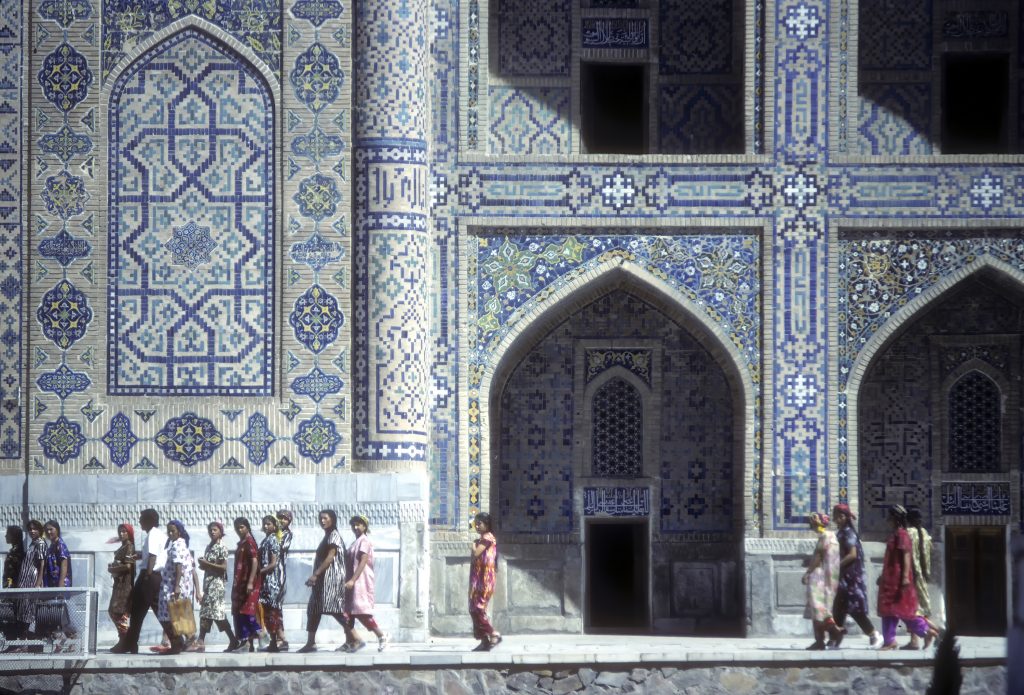
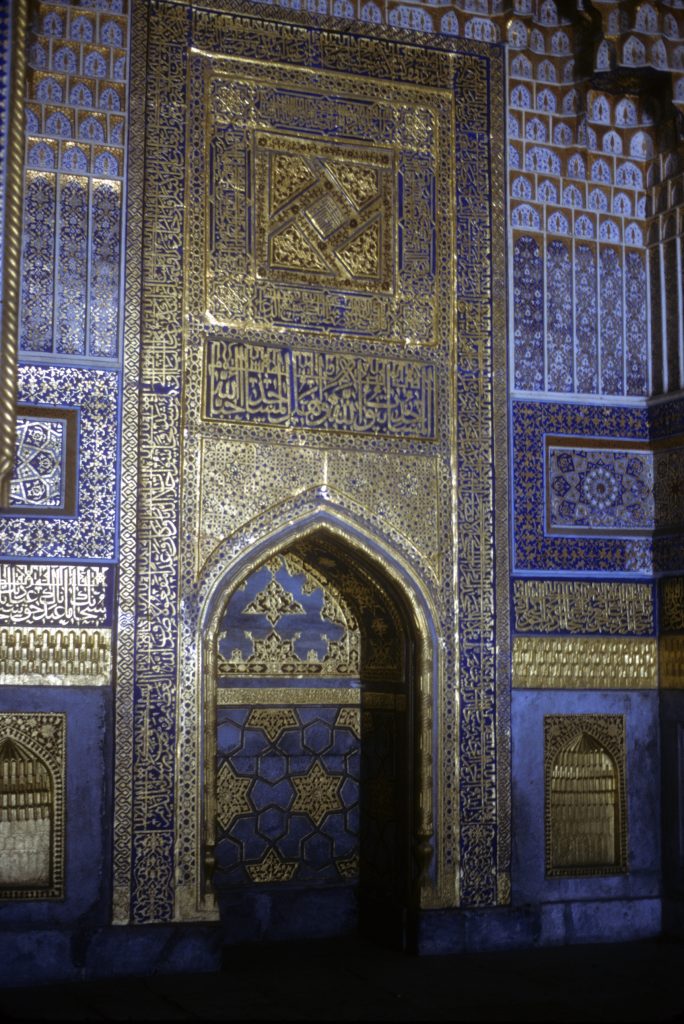

Finally, we moved on to the Gūr-i Amīr
(Uzbek: Amir Temur maqbarasi) the mausoleum of the Turco-Mongol conqueror Timur (aka Tamerlane) from the 14-15th century. It’s important in Central Asian architecture, influencing later Great Mughal architecture tombs, including Gardens of Babur in Kabul, Humayun’s Tomb in Delhi and the Taj Mahal in Agra (The Mughal dynasty of India were descendants of Timur.

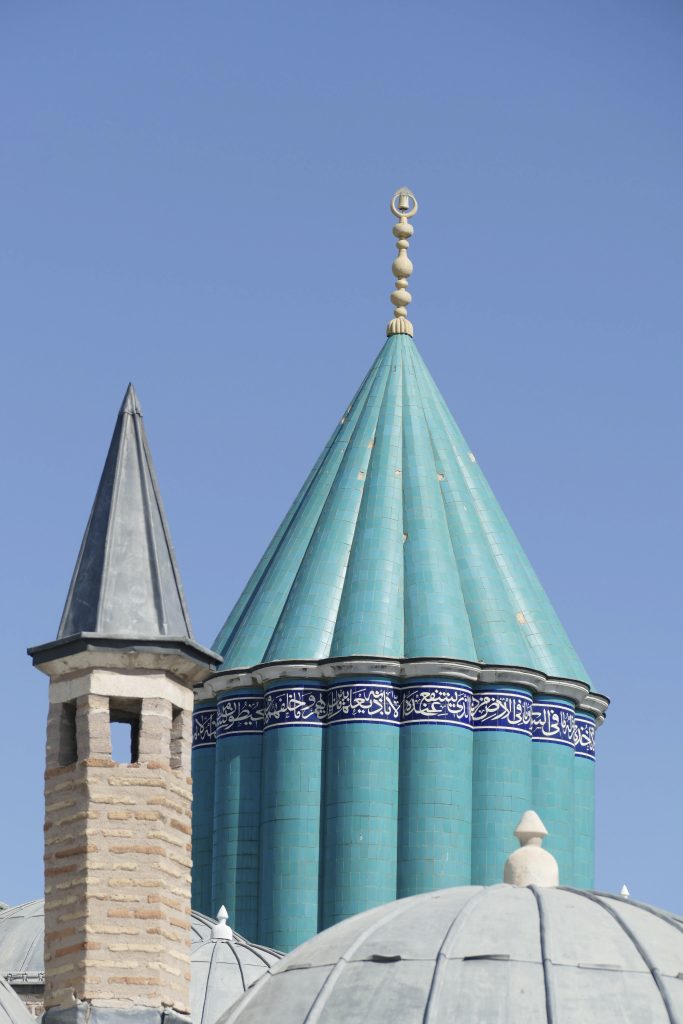
It is an octahedral building with an azure fluted dome (recalling Rumi’s Shrine in Konya, Turkey). The exterior is covered with blue and cyan Kufic calligraphic tiles with a background of terracotta bricks. The interior is large, high chamber with deep niches with the now familiar marble stalactite cornice.. The lower part of the walls are covered by large, painted onyx slabs. Other decorations on the the arches and the internal dome bas-relief plaster cartouches, gilded and painted.
The ornate carved headstones in the inner room, copied later for the Taj Mahal are not tombs but just show the location of the actual tombs in a crypt below. Under Timur’s grandson, Ulugh Beg, a solid block of dark green jade was placed over the grave of Tamerlane. It had been taken from the Chinese emperor’s palace
Leonid regaled us with the apocryphal tale of Timur’s curse:
The tomb is inscribed with two warnings that read “When I Rise From the Dead, The World Shall Tremble”. Allegedly, once opened another inscription was discovered: “Whosoever Disturbs My Tomb Will Unleash an Invader More Terrible than I”.
The tomb was opened by Mikhail Mikhaylovich Gerasimov, a Soviet archaeologist on 20 June 1941, two days before the start of Operation Barbarossa (The German invasion of USSR)
Further apocrypha which I discovered after returning home: Stalin believed in the curse and ordered Timur be reburied. The remains of Timur were taken to the frontlines of Stalingrad to inspire the Muslim troops in the Red Army. Tamerlane was reburied with full Islamic burial rites on December 20, 1942, about one month before the Soviet victory at Stalingrad. However by then, the German aarmy was already fatally isolated in Stalingrad, surrendering on 3 Feb 1943.
Waiting in yet another AC-free prop airliner. At least this time we’re in the front row and the door to the cargo compartment (and the outside) is open, so there’s a bit of a breeze
Differences from other tourist trips: we carry our own baggage, but we’re whisked thru customs — cursory inspection of baggage, but no Xrays, no passport check, then usually we’re let on ahead of the others. But then that usually means longer in the sauna!
Arrived in Tashkent about 5. Jeff, Judy, Mort & I took a cab (1.1R) to yet another bazaar (always a favorite of mine). More pictures and wonderful vegies. Spices abounded, many green herbs. Bought 2 kinds of paprika (1R). Returned to hotel in time for dish of ice cream at stand (50k).
In market saw a very old woman selling glasses of milky liquid ladled from a pail, with floating pieces of ice. Torn between temptation to quench our of thirst and images of tubercular, giardial organisms waiting for their chance. [Note from 2023: Somehow, I failed to record our decision in my journal. And can’t remember what it was.]
1 Aug WE Tashkent 10 am –> Mineralyne Voda a non-descript town in Stavropol Krai, Russia, located along the Kuma River. but then over an hour before a bus arrived so we could de-plane. Cooler here (65 F) but more humid. Overcast.
Part 3 will continue with our explorations the Caucasus